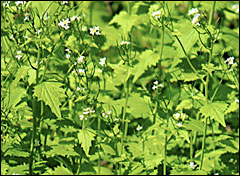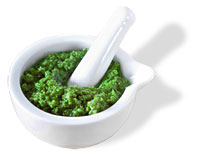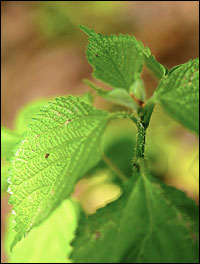Around this time of year, all the foodies in my neck of the woods are, well, in the woods. Spring and fall are the best wild food foraging times around here, and as if ol’ Mother Nature knew our food prices were going through the roof and transportation costs skyrocketing, she’s brought us a cornucopia of wild edibles out there, free for the taking.

Nettles, how sweet thy sting.
Photo: Kurt Michael Friese
Besides the morels I spoke of recently (did I mention my son found some 10 feet from our back door?), we find oyster and velvet foot and puffball mushrooms around here, and soon the goat’s beard and hen o’ the woods will be popping out. There are ramps and fiddleheads to be had in the forest as well, but the two wild foods of the week are a weed and an invader — stinging nettles and garlic mustard.
Now anyone who’s done any camping has probably developed a special kind of hatred for nettles, a plant with a natural defense so nasty that many folks recoil from eating them. When they come into contact — even slightly — with the skin, these otherwise pretty little plants release the tips of their tiny spines, and with them a wicked cocktail of acetylcholine, histamine, formic acid, and 5-hydroxytryptamine (which, curiously, is serotonin). The result is a crazy burning itch that lasts about 10 minutes. Surprisingly, though, they are quite edible — and delicious, as long as you know how to handle them. (Short version: Use gloves or tongs.) Harvested and cooked correctly, nettles deliver a burst of nutrition and flavor, and can be substituted for cooked spinach. The real sting comes when you run out.

Garlic mustard: splendor in the weeds.
Photo: Kurt Michael Friese
In my backyard right now, a pernicious invader called Alliaria petiolata — more commonly called garlic mustard — thrives. It came to the New World from Europe in the 1800s as a culinary and medicinal herb. With no natural predators here, it soon grew out of control. Extremely prolific, a single garlic mustard plant can spread into a patch of 20 to 120 feet in just a year. Garlic mustard will shade or crowd out native species of flowers and mushrooms and cause massive disruption in a habitat if left unchecked.
In Hickory Hill Park near where I live in Iowa, garlic mustard’s invasion has reached such heights of success that local volunteers pull out nearly a ton of the stuff every year! As I recently preached on Gristmill, though, one way to turn an enemy into a friend is to dine with him — or in this case, on him. As mentioned, garlic mustard is a European culinary herb, and has a pleasant, bitter, somewhat spicy character. This week I’ve eaten it in salad, on a burger (good local grass-fed beef, of course), in soup, and as one of a mélange of braising greens.
An easy way to enjoy it is in a pesto. And you can make a lot because it freezes well. Here’s a variation on the classic Italian basil pesto recipe; tinker with it to suit your fancy.
Garlic Mustard Pesto
I recommend two high-end Italian cheeses here, but you could easily substitute the domestic varieties. Don’t use the powdery stuff in the green cylinder, though. It’s full of so much cellulose you’d be better off shredding the cardboard it comes in.

From pest to pesto.
4 cups (packed) fresh garlic mustard leaves, washed
1 teaspoon of coarse sea salt
2 tablespoons of oven-toasted pine nuts (some contest this inclusion, but I like them)
3 tablespoons of grated Pecorino cheese
3 tablespoons of grated Parmigiano Reggiano cheese
1 cup of olive oil
Put the garlic, the washed garlic mustard leaves, the salt (which helps to preserve the green of the leaves), and the pine nuts into the mortar.
Slowly mix with the pestle and add the mixed cheeses a little at a time.
When the mixture is smooth and creamy, add olive oil to taste (to the texture you prefer) and stir to incorporate.
To dress your pasta with the pesto, always dilute the pesto with a little of the cooking water from the pasta.



